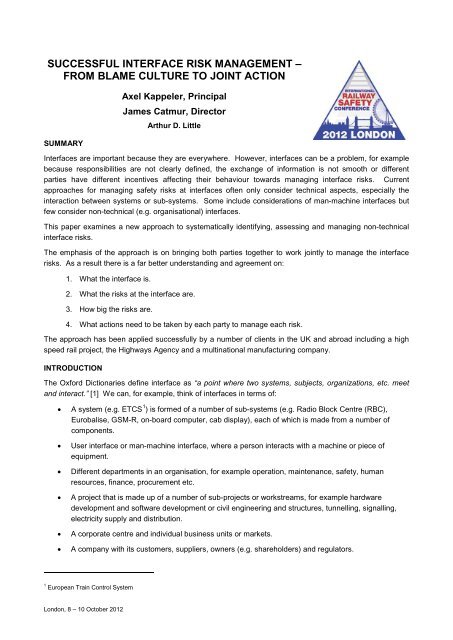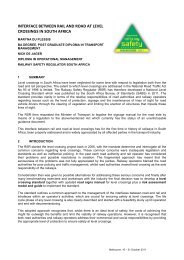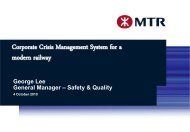successful interface risk management - International Rail Safety ...
successful interface risk management - International Rail Safety ...
successful interface risk management - International Rail Safety ...
Create successful ePaper yourself
Turn your PDF publications into a flip-book with our unique Google optimized e-Paper software.
SUCCESSFUL INTERFACE RISK MANAGEMENT –<br />
FROM BLAME CULTURE TO JOINT ACTION<br />
SUMMARY<br />
Axel Kappeler, Principal<br />
James Catmur, Director<br />
Arthur D. Little<br />
Interfaces are important because they are everywhere. However, <strong>interface</strong>s can be a problem, for example<br />
because responsibilities are not clearly defined, the exchange of information is not smooth or different<br />
parties have different incentives affecting their behaviour towards managing <strong>interface</strong> <strong>risk</strong>s. Current<br />
approaches for managing safety <strong>risk</strong>s at <strong>interface</strong>s often only consider technical aspects, especially the<br />
interaction between systems or sub-systems. Some include considerations of man-machine <strong>interface</strong>s but<br />
few consider non-technical (e.g. organisational) <strong>interface</strong>s.<br />
This paper examines a new approach to systematically identifying, assessing and managing non-technical<br />
<strong>interface</strong> <strong>risk</strong>s.<br />
The emphasis of the approach is on bringing both parties together to work jointly to manage the <strong>interface</strong><br />
<strong>risk</strong>s. As a result there is a far better understanding and agreement on:<br />
1. What the <strong>interface</strong> is.<br />
2. What the <strong>risk</strong>s at the <strong>interface</strong> are.<br />
3. How big the <strong>risk</strong>s are.<br />
4. What actions need to be taken by each party to manage each <strong>risk</strong>.<br />
The approach has been applied <strong>successful</strong>ly by a number of clients in the UK and abroad including a high<br />
speed rail project, the Highways Agency and a multinational manufacturing company.<br />
INTRODUCTION<br />
The Oxford Dictionaries define <strong>interface</strong> as “a point where two systems, subjects, organizations, etc. meet<br />
and interact.” [1] We can, for example, think of <strong>interface</strong>s in terms of:<br />
• A system (e.g. ETCS 1 ) is formed of a number of sub-systems (e.g. Radio Block Centre (RBC),<br />
Eurobalise, GSM-R, on-board computer, cab display), each of which is made from a number of<br />
components.<br />
• User <strong>interface</strong> or man-machine <strong>interface</strong>, where a person interacts with a machine or piece of<br />
equipment.<br />
• Different departments in an organisation, for example operation, maintenance, safety, human<br />
resources, finance, procurement etc.<br />
• A project that is made up of a number of sub-projects or workstreams, for example hardware<br />
development and software development or civil engineering and structures, tunnelling, signalling,<br />
electricity supply and distribution.<br />
• A corporate centre and individual business units or markets.<br />
• A company with its customers, suppliers, owners (e.g. shareholders) and regulators.<br />
1 European Train Control System<br />
London, 8 – 10 October 2012
Axel Kappeler, James Catmur<br />
Arthur D. Little<br />
Successful <strong>interface</strong> <strong>risk</strong> <strong>management</strong> – from blame culture to joint action<br />
Interfaces are important because they are everywhere. However, <strong>interface</strong>s can be a problem, for example<br />
because responsibilities are not clearly defined, the exchange of information is not smooth or different<br />
parties have different incentives affecting their behaviour towards managing <strong>interface</strong> <strong>risk</strong>s.<br />
Current approaches for managing safety <strong>risk</strong>s at <strong>interface</strong>s often only consider technical aspects especially<br />
the interaction between systems or sub-systems. Some include considerations of man-machine <strong>interface</strong>s<br />
but few consider organisational <strong>interface</strong>s.<br />
For example, MIL Standard 882 requires the creation of a System <strong>Safety</strong> Programme Plan (SSPP). This<br />
requires defining “the safety <strong>interface</strong>s between each associate contractor and subcontractor (and suppliers<br />
and vendors as applicable), e.g. integrating hazard analyses”. Preliminary Hazard Analysis (PHA), carried<br />
out as part of the safety analysis, “shall identify hazards by considering the potential contribution to<br />
subsystem or system mishaps from” … “Interface considerations to other systems when in a network or<br />
System-of-Systems (SoS) architecture.” System Hazard Analysis (SHA) is carried out “to identify previously<br />
unidentified hazards associated with the subsystem <strong>interface</strong>s and faults” … “including software and<br />
subsystem and human <strong>interface</strong>s.” [2]<br />
The terms of reference for the NATO Research and Technology Organisation (NATO RTO) report<br />
‘Validation, verification and certification of embedded systems’ states as one of its specific goals: Interface<br />
testing techniques for embedded systems which could include both specialized and Commercial-Off-The-<br />
Shelf (COTS) components. In addition chapter 4.5 of the report considers Man Machine Interfaces. [3]<br />
The Common <strong>Safety</strong> Method (CSM) on <strong>risk</strong> evaluation and assessment states that “particular attention<br />
should be paid to <strong>risk</strong> <strong>management</strong> at the <strong>interface</strong>s between the actors which are involved in the application<br />
of this Regulation.” Interfaces are defined as “all points of interaction during a system or subsystem lifecycle,<br />
including operation and maintenance where different actors of the rail sector will work together in<br />
order to manage the <strong>risk</strong>s.” Annex I of the regulation states that “for each <strong>interface</strong> relevant to the system<br />
under assessment … the rail-sector actors concerned shall cooperate in order to identify and manage jointly<br />
the hazards and related safety measures that need to be handled at these <strong>interface</strong>s”. [4]<br />
The NASA Risk Management Handbook describes two complementary processes, integrated into a single<br />
coherent framework, in order to foster proactive <strong>risk</strong> <strong>management</strong> - Risk-Informed Decision Making (RIDM)<br />
and Continuous Risk Management (CRM). “The RIDM process addresses the <strong>risk</strong>-informed selection of<br />
decision alternatives to assure effective approaches to achieving objectives.” “The CRM process addresses<br />
implementation of the selected alternative to assure that requirements are met.”<br />
“Throughout the RIDM process, interactions take place between the stakeholders, the <strong>risk</strong> analysts, the<br />
Subject Matter Experts (SMEs), the Technical Authorities, and the decision-maker to ensure that objectives,<br />
values, and knowledge are properly integrated and communicated into the deliberations that inform the<br />
decision.”<br />
The RIDM process requires that within each unit the <strong>interface</strong>s with the unit(s) at the next higher and lower<br />
levels in the organizational hierarchy are considered (e.g. when negotiating objectives and establishing<br />
performance requirements), as well as with its own unit’s CRM process. [5]<br />
Non-technical <strong>interface</strong>s, such as those between two organisations, different departments within an<br />
organisation, two projects or a number of workstreams within a project are often not systematically analysed<br />
for their safety <strong>risk</strong>s. Therefore, <strong>risk</strong> <strong>management</strong> approaches need to be extended to these non-technical<br />
<strong>interface</strong>s.<br />
But current <strong>risk</strong> <strong>management</strong> approaches, as well as the attitudes and behaviours of key players at such<br />
<strong>interface</strong>s, are often not well suited to identify, assess and manage safety <strong>risk</strong>s at <strong>interface</strong>s. Each party is<br />
typically only looking at their own ‘patch’ and, more often than not, blaming the other side if something goes<br />
wrong.<br />
London, 8 – 10 October 2012
Axel Kappeler, James Catmur<br />
Arthur D. Little<br />
Successful <strong>interface</strong> <strong>risk</strong> <strong>management</strong> – from blame culture to joint action<br />
This paper examines a new approach to systematically identifying, assessing and managing non-technical<br />
<strong>interface</strong> <strong>risk</strong>s. The approach has been applied <strong>successful</strong>ly by a number of clients in the UK and abroad<br />
including a high speed rail project, the Highways Agency and a multinational manufacturing company.<br />
AN APPROACH TO MANAGING INTERFACE RISKS<br />
The aim of the approach is to turn a typical attitude and behaviour of ‘blame the other side’ when something<br />
goes wrong into a culture of taking joint responsibility for understanding and <strong>successful</strong>ly managing safety<br />
<strong>risk</strong>s at <strong>interface</strong>s. The emphasis of the approach is on bringing both parties together to work jointly to<br />
manage the <strong>interface</strong> <strong>risk</strong>s. As a result there is a far better understanding and agreement on:<br />
1. What the <strong>interface</strong> is.<br />
2. What the <strong>risk</strong>s at the <strong>interface</strong> are.<br />
3. How big the <strong>risk</strong>s are.<br />
4. What actions need to be taken by each party to manage each <strong>risk</strong>.<br />
1. Understanding the <strong>interface</strong><br />
The first step of the approach is to clearly define and describe the <strong>interface</strong> between two parties. This<br />
sounds obvious but is often not done or done poorly. This first step is therefore not only important in terms<br />
of forming the basis for a sound <strong>risk</strong> assessment but also in terms of developing a culture of shared<br />
understanding and action between the parties. It can provide an important turning point in the relationship of<br />
the two parties and the behaviours and attitudes of individuals on both sides. Finger-pointing and blaming<br />
each other for problems that occur (such as accidents, quality problems, delays or cost overruns) make way<br />
for jointly identifying potential <strong>risk</strong>s that may occur and how to best address them (before they become<br />
problems).<br />
Interfaces can be of many types, for example hardware, software, requirements, specifications, Validation &<br />
Verification (V&V) plans etc. There are many ways of describing the <strong>interface</strong>s between two (or more)<br />
parties and the parties need to decide the most suitable representation on a case-by-case basis. The<br />
<strong>interface</strong>s could be described in form of a list or table that lists the key flows or deliveries going across the<br />
<strong>interface</strong> or it could be a flow diagram or other graphical representation. Below is an example from an<br />
<strong>interface</strong> between two projects that is structured around already existing meetings that take place between<br />
the two projects.<br />
London, 8 – 10 October 2012
Axel Kappeler, James Catmur<br />
Arthur D. Little<br />
Successful <strong>interface</strong> <strong>risk</strong> <strong>management</strong> – from blame culture to joint action<br />
Engineering meetings<br />
<strong>interface</strong><br />
• Technical solutions for<br />
feature fulfillment<br />
• Software (SW)<br />
• Hardware (HW)<br />
• V&V plan fulfillment<br />
– Uptime<br />
– Material deliveries<br />
(maturity of the material<br />
as one parameter)<br />
– Reliability growth rate<br />
(Problem solving speed,<br />
verification fulfillment)<br />
– Changes on Engine side<br />
--> leading to changes<br />
vehicle side<br />
Coordination meetings<br />
<strong>interface</strong><br />
• Feature fulfillment<br />
• Feature balancing<br />
• Business impact<br />
Planning meetings<br />
<strong>interface</strong><br />
• Vehicle to Powertrain:<br />
Material order from vehicle<br />
project of<br />
Engine/transmission<br />
deliveries<br />
• Priority of vehicles in the<br />
common plan<br />
• Vehicle to Powertrain: SW<br />
status on the truck to the<br />
engine<br />
• SW delivery plan, who is<br />
developing the SW?<br />
– Right SW in the right<br />
time for the right<br />
purpose is a key<br />
<strong>interface</strong>. The people<br />
working with the<br />
planning are stuck in<br />
short term firefighting<br />
• V&V for different engine<br />
types<br />
Other <strong>interface</strong><br />
Define the <strong>interface</strong> in terms<br />
of:<br />
• Quality & Features<br />
(technical aspects)<br />
• Delivery (timing)<br />
• Costs (product/project)<br />
• Managerial (control)<br />
Figure 1: Example <strong>interface</strong> definition based on existing meeting structure between two projects<br />
2. Identifying <strong>interface</strong> <strong>risk</strong>s<br />
There are two main approaches that can be taken to identify <strong>interface</strong> <strong>risk</strong>s:<br />
1. Bringing the parties together to identify the <strong>risk</strong>s at their <strong>interface</strong> jointly.<br />
2. Working with each party separately.<br />
In the first approach the parties that share an <strong>interface</strong> are brought together either physically in one meeting<br />
room or virtually via conference call and net-meeting.<br />
The approach used for identifying <strong>interface</strong> <strong>risk</strong>s is based the HAZOP 2 study technique and using<br />
Guidewords. HAZOP is an especially powerful technique for analysing <strong>interface</strong>s. [6,7,8,9]<br />
The approach consists of:<br />
• Defining a set of guidewords to identify <strong>interface</strong> <strong>risk</strong>s.<br />
• Applying the guidewords systematically to the <strong>interface</strong> (as defined in the first step) to identify<br />
potential <strong>risk</strong>s at the <strong>interface</strong>.<br />
• Recording the <strong>risk</strong>s in a <strong>risk</strong> register.<br />
2 Hazard and Operability<br />
London, 8 – 10 October 2012
Axel Kappeler, James Catmur<br />
Arthur D. Little<br />
Successful <strong>interface</strong> <strong>risk</strong> <strong>management</strong> – from blame culture to joint action<br />
Guidewords used in the approach cover, for example, timing, information, material, activity:<br />
Project/Project<br />
Guidewords:<br />
Timing<br />
• Early – it happens earlier than intended<br />
• Late – it happens later than intended<br />
• Before – it happens earlier in the sequence than<br />
was intended<br />
• After – it happens later in the sequence than was<br />
intended<br />
Information/material/activity<br />
• No – none is achieved<br />
• Partial/less – less is delivered than is required<br />
• More – more is delivered than is required<br />
• As well as – something else is delivered, along<br />
with what is required<br />
• Part of – only a part of what is required is<br />
delivered<br />
• Reverse – the logical opposite happens<br />
• Other than – something completely different<br />
happens<br />
Engineering<br />
meetings <strong>interface</strong><br />
Coordination<br />
meetings <strong>interface</strong><br />
Planning<br />
meetings <strong>interface</strong><br />
Other <strong>interface</strong><br />
What if technical<br />
solutions for feature<br />
fulfillment are later than<br />
intended?<br />
What feature balancing is<br />
not achieved?<br />
What if the wrong material<br />
is delivered from Vehicle<br />
to Powertrain project?<br />
What if material is<br />
delivered earlier than<br />
intended?<br />
Figure 2: Example guidewords for <strong>interface</strong> <strong>risk</strong> analysis<br />
If we identify ‘Software’ as a delivery at the <strong>interface</strong> between two projects, applying the guidewords we<br />
would, for example, ask:<br />
Timing:<br />
• What <strong>risk</strong>s can we identify if the software is delivered early?<br />
• What <strong>risk</strong>s can we identify if the software is delivered late?<br />
• What <strong>risk</strong>s can we identify if the software is delivered in a different sequence than planned, e.g.<br />
package Y is delivered before package X?<br />
Information/material/activity:<br />
• What is the <strong>risk</strong> if the software is not delivered?<br />
• What is the <strong>risk</strong> if only part of the software is delivered?<br />
• What if more functionality is delivered than was expected?<br />
• What is the software delivered has features that are not required?<br />
• What is the <strong>risk</strong> of the software delivered is completely different from that planned?<br />
It should be noted that not every guide word will make sense for each element of the <strong>interface</strong>, but the<br />
guidewords have been developed over many years to represent a good list of the failure modes of an<br />
<strong>interface</strong> so can be used to trigger thoughts about possible <strong>interface</strong> <strong>risk</strong>s.<br />
For one project we identified forty <strong>risk</strong>s during a workshop using this approach. Thirty of the <strong>risk</strong>s were new<br />
and were not already listed in the existing <strong>risk</strong> registers of either party involved at the <strong>interface</strong>.<br />
The second approach is appropriate if there is a danger that the parties would not work openly and<br />
constructively together, particularly where three or more parties are involved. This is something we<br />
experienced on another project where in a first joint workshop the parties would either not mention <strong>risk</strong>s they<br />
knew existed or they would engage in blaming and accusing each other for things that had already<br />
happened or could happen.<br />
London, 8 – 10 October 2012
Axel Kappeler, James Catmur<br />
Arthur D. Little<br />
Successful <strong>interface</strong> <strong>risk</strong> <strong>management</strong> – from blame culture to joint action<br />
In these circumstances, it is best to talk to each party separately. Each party is asked separately about the<br />
<strong>risk</strong>s they see at the <strong>interface</strong> – the <strong>risk</strong>s that their activities could cause others and the <strong>risk</strong>s they think<br />
others are causing them. The identified <strong>risk</strong>s are consolidated and entered into a <strong>risk</strong> register. In this<br />
approach it is important to preserve anonymity, i.e. you don’t tell party A which <strong>risk</strong>s were brought up by<br />
party B, which by C and which by D. The focus should be on agreeing that there is a <strong>risk</strong> and that it needs<br />
to be managed.<br />
3. Assessing <strong>interface</strong> <strong>risk</strong>s<br />
In the third step the identified <strong>interface</strong> <strong>risk</strong>s are assessed. Typical methods for assessing the likelihood and<br />
impact can be used, for example <strong>risk</strong> ranking matrices.<br />
Risk level<br />
Probability<br />
Probability<br />
Highly<br />
5 probable<br />
High<br />
>75%<br />
4 Probable<br />
50%-75%<br />
3 Possible<br />
25%-50%<br />
Medium<br />
2<br />
Low<br />
5%-25%<br />
Very Low<br />
1<br />
0-5%<br />
Low<br />
Very low Low Moderate High<br />
Very<br />
high<br />
1 2 3 4 5<br />
Severity<br />
x<br />
Severity<br />
Figure 3: Example <strong>risk</strong> ranking matrix<br />
4. Taking action to manage <strong>interface</strong> <strong>risk</strong>s<br />
In the fourth step action plans are developed to mitigate the <strong>risk</strong>s. One of the main challenges with <strong>interface</strong><br />
<strong>risk</strong>s is that the direct control of a <strong>risk</strong> can often not be attributed to one party alone or the party affected by<br />
the consequences of the <strong>risk</strong> is not the same party that causes (and often controls) the <strong>risk</strong>.<br />
Therefore, actions to mitigate the identified <strong>risk</strong>s need to be developed jointly by the parties and agreed.<br />
Each action should be conducted by the party that is best placed to take it. For each <strong>risk</strong> and action a<br />
Single Point of Accountability (SPA) should be nominated. The <strong>risk</strong> SPA is accountable that the <strong>risk</strong> is<br />
effectively managed – through one or several actions. The <strong>risk</strong> SPA does not need to be accountable for, or<br />
indeed carry out, all the actions, but he needs to make sure that the agreed actions are completed on time.<br />
The SPA should typically be a senior person, such as a department head, to provide sufficient focus and<br />
visibility. For actions the SPA can delegate responsibility for completing the action (e.g. to a person in his<br />
department or team) but remains accountable that the action is completed.<br />
This approach provides clarity and accountability for all sides as to who needs to do what by when to<br />
mitigate a specific <strong>risk</strong>.<br />
Note that for one <strong>risk</strong> more than one action may be identified or that one action may mitigate two or more<br />
<strong>risk</strong>s.<br />
Finally, the implementation of the actions needs to be monitored to check that they are being done and have<br />
the desired effect in mitigating the <strong>risk</strong>.<br />
London, 8 – 10 October 2012
Axel Kappeler, James Catmur<br />
Arthur D. Little<br />
Successful <strong>interface</strong> <strong>risk</strong> <strong>management</strong> – from blame culture to joint action<br />
Identify<br />
The <strong>risk</strong> is<br />
identified<br />
Assess<br />
The <strong>risk</strong> is<br />
assessed and its<br />
importance<br />
known<br />
Plan<br />
mitigation<br />
A plan is<br />
developed to<br />
manage the <strong>risk</strong><br />
Deliver<br />
planned<br />
mitigation<br />
The planned<br />
actions are<br />
delivered<br />
Review<br />
The planned<br />
actions reduce<br />
the <strong>risk</strong><br />
<br />
Result<br />
Good <strong>risk</strong><br />
<strong>management</strong><br />
<br />
<br />
<br />
<br />
<br />
<br />
<br />
<br />
“We implemented<br />
the action, but it did<br />
not work”<br />
“We had a good<br />
action plan, but did<br />
not do it”<br />
“We knew it was<br />
important but were<br />
too busy”<br />
“We knew about the<br />
<strong>risk</strong> but did nothing”<br />
Source: Arthur D. Little<br />
Common stopping point<br />
Figure 4: Good <strong>risk</strong> <strong>management</strong> does not stop once <strong>risk</strong>s have been identified and assessed – it<br />
makes sure <strong>risk</strong>s are managed<br />
London, 8 – 10 October 2012
Axel Kappeler, James Catmur<br />
Arthur D. Little<br />
Successful <strong>interface</strong> <strong>risk</strong> <strong>management</strong> – from blame culture to joint action<br />
CONCLUSION<br />
Interfaces are important because they are everywhere. However, current approaches for managing safety<br />
<strong>risk</strong>s at <strong>interface</strong>s often only consider technical aspects and whilst some include considerations of manmachine<br />
<strong>interface</strong>s few consider non-technical (e.g. organisational) <strong>interface</strong>s.<br />
This paper proposes a new approach to systematically identifying, assessing and managing non-technical<br />
<strong>interface</strong> <strong>risk</strong>s. The emphasis of the approach is on bringing both parties together to work jointly to manage<br />
the <strong>interface</strong> <strong>risk</strong>s. As a result there is a far better understanding and agreement on:<br />
1. What the <strong>interface</strong> is.<br />
2. What the <strong>risk</strong>s at the <strong>interface</strong> are.<br />
3. How big the <strong>risk</strong>s are.<br />
4. What actions need to be taken by each party to manage each <strong>risk</strong>.<br />
Core to the approach used for identifying <strong>interface</strong> <strong>risk</strong>s is a HAZOP style assessment using Guidewords.<br />
HAZOP is an especially powerful technique for analysing <strong>interface</strong>s. The paper also proposes a framework<br />
for managing the identified <strong>risk</strong>s to make sure they actually reduce <strong>risk</strong> – an area often overlooked or<br />
conducted poorly in many organisations.<br />
The approach outlined in this paper has been applied <strong>successful</strong>ly by a number of clients in the UK and<br />
abroad including a high speed rail project, the Highways Agency and a multinational manufacturing<br />
company.<br />
REFERENCES<br />
[1] http://oxforddictionaries.com/<br />
[2] Department of Defence standard practice system safety, MIL-STD-882E, 11 May 2012<br />
[3] North Atlantic Treaty Organisation, RTO technical report TR-IST-027, Validation, verification and<br />
certification, of embedded systems, published October 2005<br />
[4] Commission Regulation (EC) No 352/2009 of 24 April 2009 on the adoption of a common safety<br />
method on <strong>risk</strong> evaluation and assessment as referred to in Article 6(3)(a) of Directive 2004/49/EC of<br />
the European Parliament and of the Council<br />
[5] NASA Risk <strong>management</strong> handbook pre-decisional first draft, NASA/SP-2011-XXX, Version 1.0, XXXXX<br />
2011<br />
[6] Catmur J, Chudleigh M, Redmill F, System safety: HAZOP and software HAZOP (Hardback, 1999)<br />
[7] Kletz T, Hazop and Hazan – Identifying and assessing process industry hazards, 4 th edition, IChemE,<br />
1999<br />
[8] Chemical Industries Association, A guide to hazard and operability studies, 1990<br />
[9] Kletz T, Hazop and Hazan, Notes on the identification and assessment of hazards, loss prevention, The<br />
Institution of Chemical Engineers Information Exchange Scheme, Hazard workshop modules<br />
London, 8 – 10 October 2012















